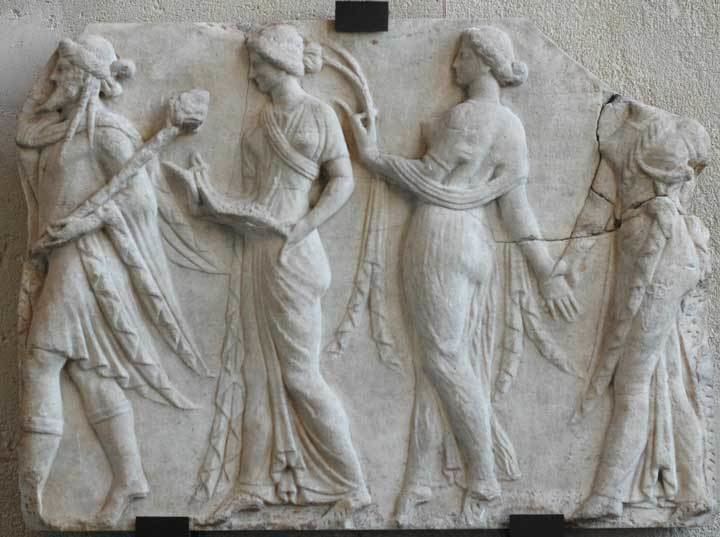 | ||
Similar Hegemone, Pasithea, Thalia (Grace) | ||
In Greek mythology the Horae or Horai (/ˈhɔːriː/ or /ˈhɔːraɪ/) or Hours (Greek: Ὧραι, Hōrai, [hɔ̂ːraj], "Seasons") were the goddesses of the seasons and the natural portions of time. They were originally the personifications of nature in its different seasonal aspects, but in later times they were regarded as goddesses of order in general and natural justice. "They bring and bestow ripeness, they come and go in accordance with the firm law of the periodicities of nature and of life", Karl Kerenyi observed: "Hora means 'the correct moment'." Traditionally, they guarded the gates of Olympus, promoted the fertility of the earth, and rallied the stars and constellations.
Contents
- The earlier Argive Horae
- The classical Horae triads
- First triad
- Second triad
- Third triad
- The Four Seasons
- The Hours
- The nine Hours
- The ten or twelve Hours
- References
The course of the seasons was also symbolically described as the dance of the Horae, and they were accordingly given the attributes of spring flowers, fragrance and graceful freshness. For example, in Hesiod's Works and Days, the fair-haired Horai, together with the Charites and Peitho crown Pandora—she of "all gifts"—with garlands of flowers. Similarly Aphrodite, emerging from the sea and coming ashore at Cyprus, is dressed and adorned by the Horai, and, according to a surviving fragment of the epic Cypria, Aphrodite wore clothing made for her by the Charites and Horai, dyed with spring flowers, such as the Horai themselves wear.
The number of Horae varied according to different sources, but was most commonly three, either the trio of Thallo, Auxo and Carpo, who were goddesses of the order of nature; or Eunomia, Diké, and Eirene, who were law-and-order goddesses.
The earlier Argive Horae
In Argos, two Horae, rather than three, were recognised presumably winter and summer: Auxesia (possibly another name for Auxo) and Damia (possibly another name for Carpo).
In late euhemerist interpretations, they were seen as Cretan maidens who were worshipped as goddesses after they had been wrongfully stoned to death.
The classical Horae triads
The earliest written mention of Horai is in the Iliad where they appear as keepers of Zeus's cloud gates. "Hardly any traces of that function are found in the subsequent tradition," Karl Galinsky remarked in passing. They were daughters of Zeus and Themis, half-sisters to the Moirai.
The Horai are mentioned in two aspects in Hesiod and the Homeric Hymns:
First triad
Of the first, more familiar, triad associated with Aphrodite and Zeus is their origins as emblems of times of life, growth (and the classical three seasons of year):
At Athens, two Horae; Thallo (the Horae of spring) and Carpo (the Horae of autumn), also appear in rites of Attica noted by Pausanias in the 2nd century AD. Thallo, Auxo and Carpo are often accompanied by Chione, an Aurae; a daughter of Boreas (the god/personification of the North Wind) and Orithyia/Oreithyia (originally a mortal princess, who was later deifyied as a goddess of cold mountain winds), and the goddess/personification of snow and winter. Along with Chione, Thallo, Auxo and Carpo were a part of the entourage of the goddess of the turn of the seasons, Persephone.
Second triad
Of the second triad associated to Themis and Zeus for law and order:
Third triad
Hyginus (Fabulae 183) identifies a third set of Horae:
The Four Seasons
Nonnus in his Dionysiaca mentions a distinct set of four Horae, the daughters of Helios. Quintus Smyrnaeus also attributes the Horae as the daughters of Helios and Selene, and describes them as the four handmaidens of Hera. The Greek words for the four seasons of year:
The Hours
Finally, a quite separate suite of Horae personified the twelve hours (originally only ten), as tutelary goddesses of the times of day. The hours run from just before sunrise to just after sunset, thus winter hours are short, summer hours are long:
The nine Hours
According to Hyginus, the list is only of nine, borrowed from the three classical triads alternated:
The ten or twelve Hours
This last distinct set of ten or twelve Hours is much less known:
